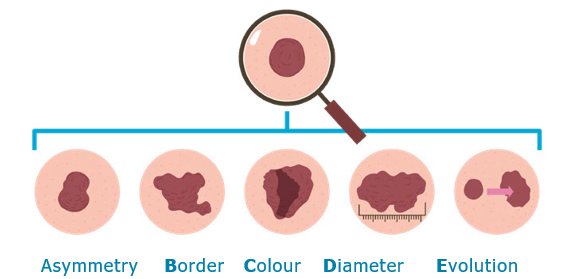How do you recognise a melanoma?6
A new or old "birthmark" that grows rapidly, itches, bleeds or changes color is alarming. It is best to detect melanoma in its early stages.
How do you recognise a suspicious mark?
Melanoma can form on “healthy” skin, without an existing pigmented spot, as well as on an existing birthmark. The best way to prevent melanoma is to be very vigilant and to examine your skin regularly, regardless of your skin type. This means you should look at yourself, but also look at your family and friends and don’t hesitate to consult a doctor as soon as something new appears on your skin, as soon as something old starts to grow, change shape or colour, itch or bleed when touched.
The earlier melanoma is detected, the greater the chance that timely intervention can be made.
Where should I look?
Examine your entire body, both front and back. Don’t forget to look behind the ears, under the breasts, on your head, under the arms, genitals, feet and between the toes.
You can easily do this yourself by standing in front of a standing mirror and looking at yourself with a hand mirror or ask someone else to look at your skin in the inaccessible places.
The ABCDE-method of recognizing malignant birthmark
A new or old “birthmark” that grows quickly, itches, bleeds, or changes colour is alarming. To detect melanoma at an early stage, the ABCDE rule is useful:
- A for Asymmetry: the (birth)mark is not symmetrical in colour or shape, one half does not match the other half.
- B for Border – for irregular borders: the (birth)mark has an irregular jagged edge
- C for Colour – for colour: the (birth)mark changes colour or has different colours
- D for Diameter: which is often larger than 6 mm, the cross section of a pencil
- E for Evolution: the (birth)mark has changed in size, shape or colour.

Birthmarks that look different to the others are also something to keep an eye on. We call it the “ugly duckling” sign.
What can I do to prevent melanoma?
Some people are more at risk than others of developing melanoma. This can be because, for example, they:
- are exposed to a lot of sun
- have pale skin and tend to get sunburned
- were sunburned during their childhood
- have used or use sunbeds
- have more than 50 birthmarks (nevi)
- have a family history of skin cancer
- have Parkinson’s disease or a family history of it
- have had an organ transplant or taken immunomodulators
But whether you’re at high risk or not, there are simple ways to prevent melanoma.
- Beware of the sun
- Regular sunburn or UV rays from sunbeds are the main causes of melanoma.
- Avoid unnecessary exposure (sunbathing) and sunbed sessions.
- Protect yourself: with loose-fitting clothing that protects your arms and legs, a hat or cap for your neck and face, and sunglasses for your eyes.
- During sunny periods, use a sunscreen with a high protection factor against UVB and UVA rays. Apply the sunscreen half an hour before exposure and repeat every 2 hours.
- Avoid the sun as much as possible between 12:00 p.m. and 3:00 p.m. (summertime)
Actions for a suspicious birthmark
See a doctor, family doctor (GP) or dermatologist quickly. Don't ignore a suspicious spot, hoping it will disappear on its own. Don't wait to see how it will develop. Try not to remove or treat the suspicious birthmark yourself either. Your family doctor or dermatologist can best diagnose whether or not the melanoma is malignant.


